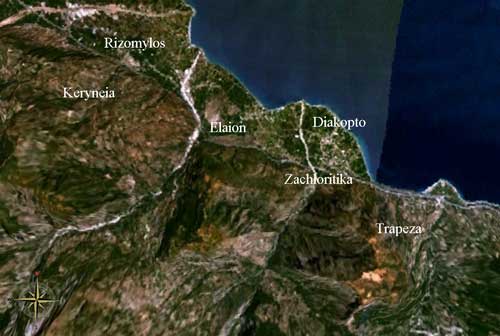- BBC Science on the discovery of Helike
- The Lost City of Helike, Greece
- Strabo, on Helike
.

Helike near Rizomylos in the municipality of Diakopto
Helike (Greek: Ελικη pron. huh-LEE-kee) was an ancient Greek city that sank c. 373 BC at night. The city was located in Achaea, Northern Peloponnesos, two kilometres (12 stadia) from the Corinthian Gulf. The related city of Boura was located nearby. Dr. Dora Katsonopoulou, President of the Helike Society, and Dr. Steven Soter of the American Museum of Natural History rediscovered the city in the summer 2001, near the village of Rizomylos. The World Monuments Fund included Helike in its 2004 List of 100 Most Endangered Sites in an effort to protect the site from destruction.
History
Helike was founded in the Bronze Age, becoming the principal city of Achaea. Helike led the twelve cities of the first Achaean League, and founded colonies, including Priene in Asia Minor and Sybaris in South Italy. Its pan-Hellenic temple and sanctuary of Helikonian Poseidon was known through the Classical world.
The city was destroyed in 373 BC, two years before the Battle of Leuctra.
The event happened on a winter night. Several events warned of the disaster. Some "immense columns of flame" appeared, and five days previous, all animals and vermin fled the city, going toward Keryneia.
The city and a space of 12 stadia below it sank into the earth, and were covered over by the sea. All the inhabitants perished, and not a trace remained, except for a few fragments projecting from the sea. Ten Spartan ships ancored in the harbour were dragged down with it. An attempt involving 2000 men to recover bodies was unsuccessful. Its territory was taken possession of by the Aegium.
The catastrophe was attributed to the vengeance of Poseidon, whose wrath was excited because the inhabitants of Helike had refused to give their statue of Poseidon to the Ionian colonists in Asia, or even to supply them with a model. According to some authorities, the inhabitants of Helike and Bura had even murdered the Ionian deputies.
About 150 years after the disaster, the philosopher Eratosthenes visited the site and reported that a standing bronze statue of Poseidon was submerged in a poros, "holding in one hand a hippocamp", where it posed a hazard to those who fished with nets.
Around 174 AD, the traveler Pausanias visited a coastal site still called Helike, located 7 km southeast of Aigion, and reported that the walls of the ancient city were still visible under water, "but not so plainly now as they were once, because they are corroded by the salt water".
For centuries after, its submerged ruins could still be seen. Later the site silted over and the location was lost.
A Roman city was built on the site.
Recent events
On August 23, 1817, a similar disaster occurred on the same spot. The earthquake was preceded by a sudden explosion, like that of a battery of cannon. The after shock was said to have lasted a minute and a half, during which the sea rose at the mouth of the Selinus, and extended to cover all the level immediately below Vostitza (the ancient Aegium). After its retreat not a trace was left of some magazines which had stood on the shore, and the beach was carried away completely. In Vostitza 65 persons lost their lives, and two thirds of the buildings were entirely ruined. Five villages in the plain were destroyed.
Scholars who visited the ruins
- The Greek geographer Strabo
- The Greek traveler Pausanias
- The Greek historian Diodoros of Sicily
- The Roman writer Aelian
- The Roman poet Ovid.
Rediscovery
The Greek archeologist Dora Katsonopoulou rediscovered the city in 2001, buried in an ancient lagoon. Another city found nearby, dating from the Bronze Age (around 2400 BC) shared the same fate as Helike, just two millennia earlier.
References
- Giovannini, A (1985). 'Peut-on démythifier l'Atlantide?', Museum Helveticum, vol. 42, pp. 151-156. (French)
- Katsonopoulou, D (2002). 'Helike and her Territory in Historical Times', Pallas, vol. 58, pp. 175-182.
- Lafond, Y (1998). 'Die Katastrophe von 373 v. Chr. und das Versinken der Stadt Helike in Achaia', in E Olshausen & H Sonnabend (Edd.), Naturkatastrophen in der antiken Welt (= Stuttgarter Kolloquium zur historischen Geographie des Altertums, vol. 6), Stuttgart: Steiner, pp. 118-123. (German) ISBN 3-515-07252-7
- Marinatos, SN (1960). 'Helike. A submerged town of classical Greece', Archaeology, vol. 13, pp. 186-193.
Links
| Ancient Greece
Science, Technology , Medicine , Warfare, , Biographies , Life , Cities/Places/Maps , Arts , Literature , Philosophy ,Olympics, Mythology , History , Images Medieval Greece / Byzantine Empire Science, Technology, Arts, , Warfare , Literature, Biographies, Icons, History Modern Greece Cities, Islands, Regions, Fauna/Flora ,Biographies , History , Warfare, Science/Technology, Literature, Music , Arts , Film/Actors , Sport , Fashion --- |
Retrieved from "http://en.wikipedia.org/"
All text is available under the terms of the GNU Free Documentation License


